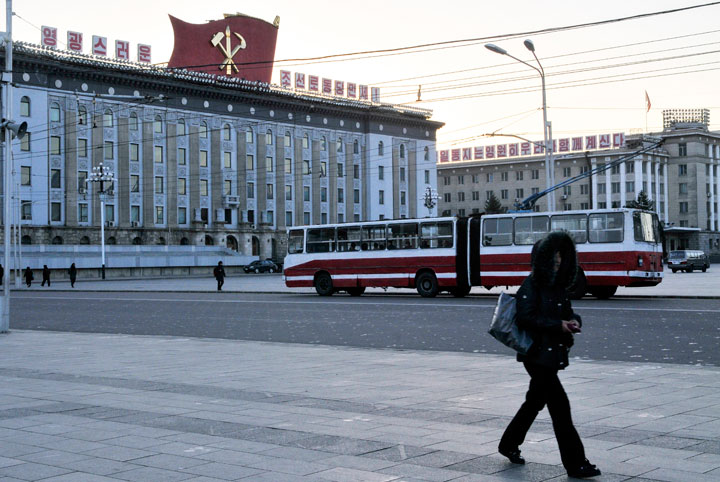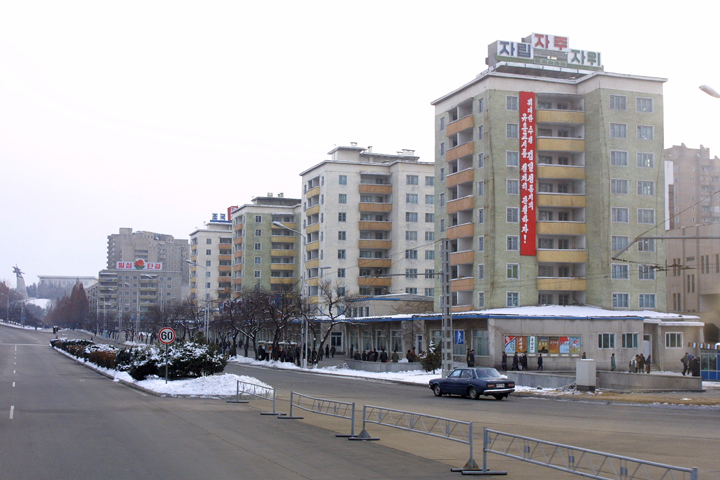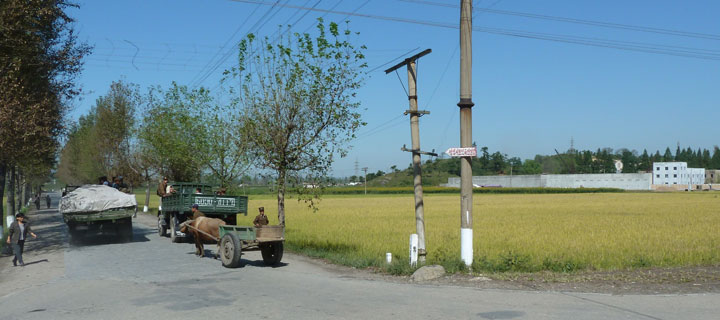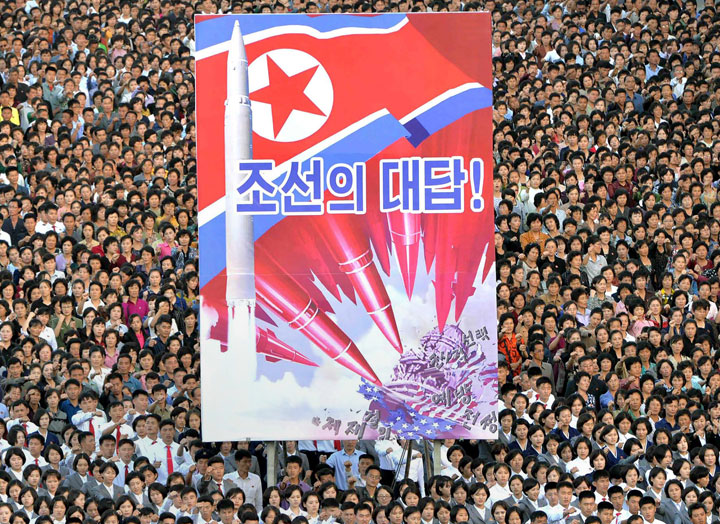When David Slinn got off the plane in Pyongyang in 2002, his first impression of the city was that it was, in a word, “Soviet.”

“The architecture. The feel on the streets. The lack of animation. The lack of advertising,” all made it feel like the Soviet Union, he said.
“On the first morning I was there, I went for a walk in the area around the embassy. And what struck me was just the lack of cars. All I could hear was the sound of shuffling feet as people went about their business.”
In the early 2000s, North Korea was led by Kim Jong Il, the father of current leader Kim Jong Un. The country was recovering from a massive famine in the 1990s which killed between a few hundred thousand and three million people, according to estimates. And although it withdrew from a nuclear non-proliferation agreement in 2003, it was still engaging with the world through multi-party talks.
Slinn, who served as the United Kingdom’s first ambassador to North Korea for just over three years from 2002 to 2006, lived in Pyongyang at a time when there was a feeling across the European Union that North Korea wanted to open up to the world.
“It didn’t work,” he said, bluntly. “The North Koreans did not follow through on their earlier signs of engagement. But having embassies there plays a useful role.”
In telephone interviews from Vienna, where his wife Heidi Hulan is Canada’s newly appointed ambassador to Austria, Slinn told Global News about life in the reclusive country and what North Koreans thought about the rest of the world.
Pyongyang, where Slinn was based, is a city that currently has a population of about 2.8-million people – about the same population as Metro Vancouver. It’s generally thought to be wealthier than the rest of the country and like many capital cities, it’s filled with grand monuments. It’s only about 195 km from the South Korean capital of Seoul, but life north of the DMZ is very different.
Life in North Korea
Foreigners like him were prevented from speaking freely with ordinary North Koreans, he said.
“It would be wrong to claim that there were free and open conversations with North Koreans. There weren’t then and from what I understand there aren’t now.”
But over time, he said, he was able to put together a picture of how people lived.
WATCH: North Korea says Donald Trump inciting ‘reckless campaign’ against regime

Many were dealing with the breakdown of the government system, where everything was provided through the work unit, he said. Rations, housing, equipment and more used to be provided, but that was no longer the way things worked.
“People had to try and adapt, to start having to look after themselves and after their interests. That was a challenge and it came through in some of the things they said.”

Get breaking National news
According to the CIA World Factbook, North Korea’s GDP per capita is one of the lowest in the world, roughly on par with Sierra Leone or Haiti – though, of course, due to the country’s secretive nature, its GDP is an estimate only.
Although things have improved since the famine of the 1990s, hunger and malnutrition continue to be widespread, according to a 2014 United Nations report.
WATCH: In May 2016, Singaporean photographer Aram Pan was permitted by North Korea to conduct a photographic flight over Pyongyang.

Most of the people Slinn knew in Pyongyang lived in sparsely furnished apartments, with intermittent access to electricity. And they assumed the rest of the world lived in similar conditions.
“Some people assumed that we had power cuts, that we in the West had power cuts 18 hours a day as well. And they’d be in shock when we said: ‘Actually, that’s not the case.’”
Others assumed that there was strict food rationing and food shortages in all other countries too, he said. “I pointed out that food rationing in the U.K. was phased out in 1954 and people were free to buy what they wanted. And I’d see people’s reactions to that sort of comment and it was quite interesting.”
In the occasional carefully monitored visit to the countryside, he was able to see how people lived outside the capital. “Just by driving through towns, driving through villages, walking around, you get a feel for the level of deprivation, the level of their hardship.”
One person approached him at a hospital, looking for help from the British embassy, he said, “because they had received no supplies from Pyongyang for five years.”
Information control
None of this was hard to see, he said.
“They didn’t try to hide it. Part of the system’s narrative was the reason for it: of course, it was all the Americans’ fault. That was the official narrative.”
North Koreans had an answer to every question, he said, and questions about bad things were usually answered by blaming the U.S.
“How the Americans were trying to strangle the country, strangle the people and it was only the bravery, the intrepid nature of the people, that was allowing them to survive.”
WATCH: After the latest round of U.N. sanctions, North Korea launched a tirade against its enemies, vowing to “sink” Japan with nuclear weapons and “reduce the United States to ashes.”

People honestly didn’t know much about the outside world, he said.
“I asked somebody, did it ever occur to him to question what the main newspaper was telling him was the truth? And he looked at me and said, ‘Why are you asking that?’ in genuine confusion. Genuinely perplexed.”
It made diplomatic negotiations difficult. Usually, both sides have a shared understanding of the other side’s position, even if they disagree, he said. But the people he spoke with only knew the regime’s propaganda on Western countries, and a couple of extra tidbits of information they picked up.
“How do you try to talk through a dispute with somebody when they have no understanding of Western society?”
Canada has mostly stayed out of the current U.S.-North Korea dispute, though it has condemned the country’s missile tests. Canadian negotiators did however successfully obtain the release of Pastor Hyeon Soo Lim in August after he had been imprisoned in North Korea since 2015.
North Koreans have a better understanding of the outside world now than during his stay, thinks Slinn, and the government control over outside information has diminished.
“A fair number of the population are now watching South Korean movies illicitly. A fair number are now listening to foreign radio broadcasts.
“But I’d be prepared to wager that a large proportion of the population outside the capital have absolutely no idea what’s going on outside the country.”
WATCH: Commander of Carrier Strike Group Five, Marc Dalton, says the purposes of the joint military exercises with South Korea this past week are purely defensive.

Opening up
Slinn believes that getting North Koreans more information is one of the best ways to change the country.
“Then they can see, they can judge for themselves how bad their plight is and how the regime narrative is a pack of lies.”
He also hopes that sanctions will put pressure on the regime.
“Sanctions get a bad press but I think that sanctions may yet work, may yet have an impact.”
Having a nuclear-armed country with a young, inexperienced leader that we know so little about is “a cause for concern.” Kim Jong Un is also unlikely to negotiate away his nuclear capabilities, said Slinn, but he hopes that defence and deterrence will work, as they did during the Cold War.
In the meantime, he thinks, countries should “prepare for the long game” and hope that increased information helps to change North Korea from the inside out.
“It’s a longer term game, but it’s one that may yet pay off in North Korea.”













Comments